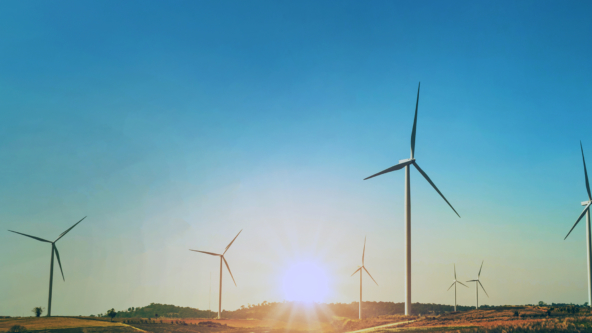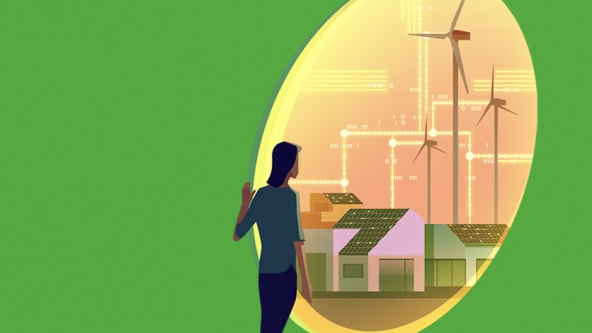Wind energy is the backbone of Europe’s renewable industry. From Denmark to Germany, wind is fast becoming the cheapest, most abundant source of electricity. And the UK is catching on.
If there’s one thing Britain can rely on, it’s a plentiful supply of wind. Wind energy generated over half of the UK’s renewable electricity in 2017 (almost 15% of all generation), a 33% increase on 2016. Higher wind speeds were responsible for some of the increase, but installed capacity also grew by 23% – the second highest growth rate in the EU.
When other renewables fail, wind often picks up the slack, making wind energy perhaps the most important resource to help meet the UK’s 2020 renewable goals. Yet despite being Europe’s third largest wind generator (behind Germany and Spain), the Government has recently made it harder for some wind projects to get off the ground.
Whether it’s pandering to a minority of sceptics, or a debate between offshore and onshore wind, there’s a lot of misinformation clouding the public forum. So, let’s dispel some of that confusion by exploring exactly what wind energy is, how it works, and why the UK’s blustery weather is a boon to its citizens.
The first wind turbine and beyond
It would be hard to write about wind energy without first mentioning our intrepid ancestors who used it to sail across the ocean. Or, indeed, the multitude of cultures from east to west that used windmills to pump water and grind cereal crops. Even the humble weathervane is a symbol of wind energy’s ability to both inform and improve our lives.
But millennia of experimenting with one of Earth’s fundamental forces culminated in something really special in 1887. In the village of Marykirk, Scotland, Professor James Blyth invented the world’s first wind turbine. Standing at around ten metres tall, it was made of cloth sails connected to a flywheel and a dynamo that converted kinetic energy into electrical energy, subsequently stored in lead-acid batteries.
Whenever the wind blew, Blyth’s holiday home would brighten with electric light, no doubt scaring the locals with this mysterious new power. He then went on to provide a better turbine design for emergency use in a local lunatic asylum in Montrose.
When Blyth was adding the finishing touches to his wind turbine, another wind energy enthusiast across the pond in Cleveland, US, was building his own. Charles Brush’s turbine was considerably larger than Blyth’s, almost double its height, and with substantially more blades. Like Blyth’s turbine, Brush used his to illuminate his home and power small machines and appliances, but it fell out of use once centralized generation reached Brush’s home.
Other notable wind pioneers include Poul La Cour, a Dane who used wind power and his own electricity regulator to power his village in 1895; Joe and Marcellus Jacobs who began manufacturing turbines for rural, off-grid applications like farm lighting in 1927; and Palmer Cosslett Putnam, an engineer who constructed the first utility-scale turbine in 1941.
Now there are over 340,000 wind turbines spinning around the world, with a combined capacity of 487 GW. That’s enough to power almost half a billion homes*. In the UK, we’ve installed nearly 20 GW, but we’ll need a lot more to fully take advantage of our boisterous wind speeds. To understand the potential of wind energy in the UK, let’s examine how we capture it.
On the shoulders of giants
How wind turbines work
Wind turbines operate on the same principle as a child’s pinwheel. The harder the wind blows, the more kinetic energy it carries. A wind turbine captures some of this kinetic energy – up to 59.3% according to Betz’s Law – and converts it into electricity, similar to how a dynamo on a bicycle wheel powers an electric lamp.
Although wind turbines can be either vertical or horizontal, nearly all commercial, utility-scale turbines are horizontal, as they generate more power. A horizontal turbine consists of three basic parts: the tower, the rotor, and the nacelle.
Due to the varying topography of the Earth’s surface, wind speeds are slower at ground or sea level than they are many metres up. Therefore most wind turbines have very tall towers. The offshore extension at Burbo Bank, for example – which generates enough electricity for 230,000 UK homes – reaches almost 200 metres in height. The tower ensures that the wind turbine is at the right height to catch the strongest winds.
At the top of the tower is the rotor and nacelle. The rotor is the bit that moves, and consists of three long blades aerodynamically designed to catch as much kinetic energy from the wind as possible. Having three blades minimises mechanical stress on the turbine, while longer blades capture more wind energy. In March this year, GE Renewable Energy announced plans to build the largest, most powerful turbine by 2021 with an impressive 107-metre blade length. Most existing wind turbines use 35 to 60-metre blades.
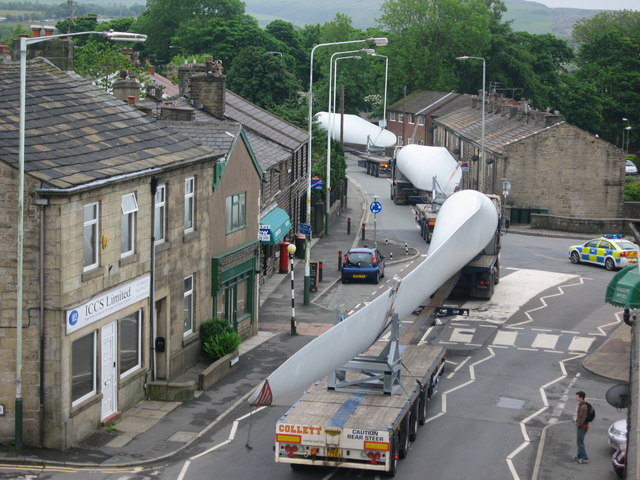
Rotor blades on their way to South Moor Wind Farm, image courtesy of Paul Anderson
The nacelle is the oblong box at the back of the rotor. Inside, the rotor is connected to a low-speed shaft that rotates around 30 RPM. The low-speed shaft is connected to a gearbox which turns another shaft at around 1,600 RPM. A generator then converts the higher revolutions into electricity.
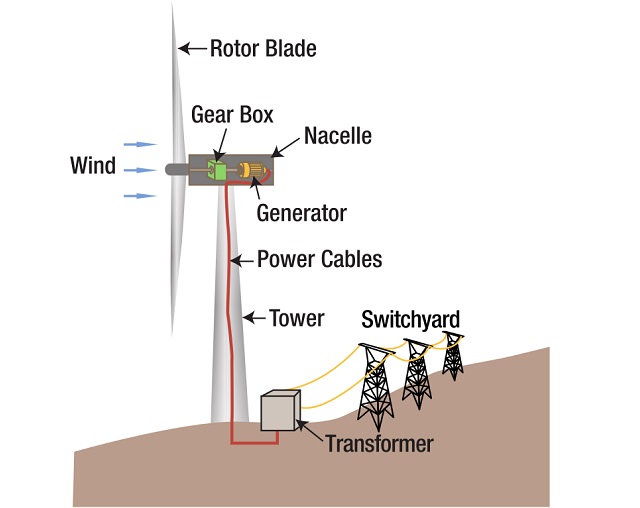
The different components of a wind turbine, Wikimedia Commons
There’s an anemometer attached to the nacelle for calculating wind speeds, and a wind vane for direction. The rotor and nacelle are fixed to a rotation mechanism so if the wind changes direction, the turbine can turn into it and continue capturing maximum energy.
While higher wind speeds do produce more wind energy, there’s a limit to how much a turbine can stand. To prevent damage, the nacelle includes a braking mechanism that stops the rotor when wind speeds are dangerous to the turbine or its environment. For utility-scale turbines the survival speed (as it’s called) is 89-161 mph, depending on the design.
Despite such large forces, wind turbines are sturdy machines, lasting around 25 years. They need more maintenance as they age, and in particularly stormy sites might need to be replaced sooner.
Where should we put them?
Understanding where to put a wind turbine is a difficult task. As the Earth is not a single uniform plane, physical and meteorological factors influence wind speed and direction, making them tough to predict with exacting accuracy.
Any new wind site assessment starts with meteorological data, to understand the historic wind speed and direction in a particular area. Natural phenomena, such as bent trees or coastal erosion, emphasise historic patterns and will add to a proposed site’s credibility. Engineers must also pay careful attention to geographical features like valleys and hills which can boost speed, or conversely, forests and other obstacles that create turbulence or reduce speed.
Ideally, wind farms should be located in open areas, facing the wind, with few or no obstacles in the way, and close enough to the electricity grid to avoid the cost of building extensions to the network. And, as turbines themselves affect wind flow, called the parking effect, they should be spaced far enough apart to avoid interfering with one another.
Onshore versus offshore
Utility-scale wind turbines are grouped together in wind farms, either offshore or onshore. Offshore wind farms have several benefits – they’re less prominent (being out at sea), wind speeds and direction are more predictable (there are fewer obstacles), and they can act as artificial reefs for marine life. It’s hard to imagine an outright winner between onshore and offshore wind. On the one hand, onshore wind is cheaper and more established; on the other, offshore wind captures more energy, are generally larger in size, and are less visually obtrusive.
What are the benefits of wind energy?
Wind energy is sustainable
For as long as the Earth has an atmosphere, the wind will blow. To waste such an abundant source of energy would mean giving up many of its environmental and social benefits. We have the technology to exploit wind energy economically, and under the threat of pollution and climate change, a moral imperative to use it.
Although a wind turbine doesn’t emit greenhouse gases while generating electricity, setting up and maintaining a wind farm involves complex supply chains that aren’t always carbon neutral. But once the wind farm is operational it compensates for these emissions many times over. In this study of two 2MW wind turbines, the authors concluded it would take between 5.2 and 6.4 months for a single turbine to offset the energy used in its manufacture. Given the average turbine lifespan of 25 years, that’s a rewarding trade-off for the environment.
Some critics argue that wind’s variability increases the need for cycling – spinning up gas-fired generators when wind underperforms – thereby increasing emissions. However, cycling is a balancing mechanism for all generation, not just wind, and as illustrated in this study by NREL, wind makes a negligible difference. Indeed, since 1990, wind and solar have reduced UK CO2 emissions by 43%.
Wind energy is cheap
IRENA’s Renewable Power Generation Costs in 2017 report predicts onshore wind to be the cheapest form of electricity generation by 2020. In 2017, wind energy averaged $0.07 (around 5p) per kWh across the globe. In Germany, for example, new projects cost as little as $0.03 (around 2p) per kWh. Fossil fuels, it would seem, are on the ropes.
The last ten years certainly add weight to this prospect. In the UK alone, wind costs have fallen 66% since 1989, with no signs of slowing. Although offshore wind is more expensive than gas, subsidies have halved since 2015’s Contract-for-Difference auctions, making it cheaper than new nuclear.
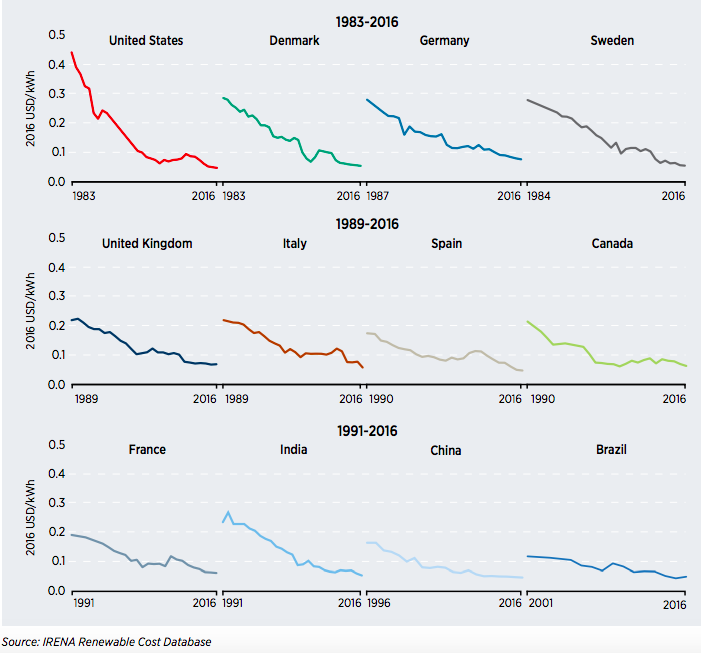
In the BEIS Electricity Generation Cost Report released in 2017, the government estimates levelised costs of electricity (LCOE) for various forms of generation. The government defines levelised costs as the “discounted lifetime cost of ownership and use of a generation asset, converted into an equivalent unit of cost of generation in £/MWh.”
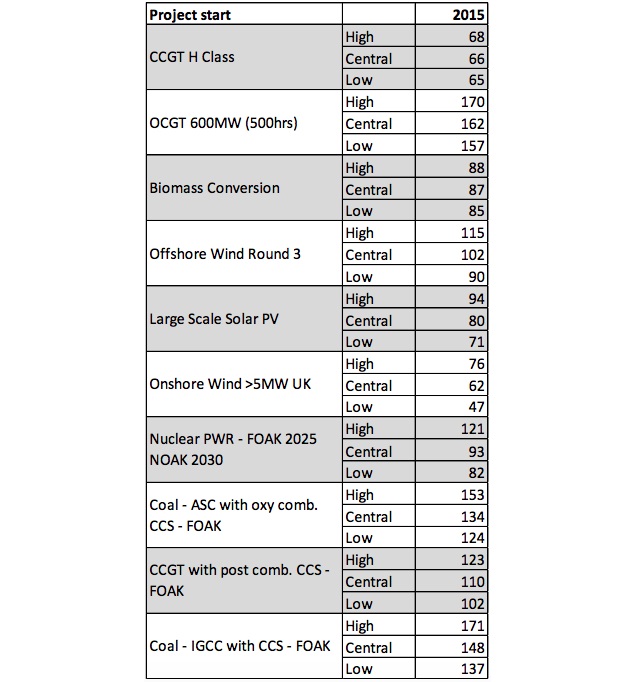
Levelised Cost Estimates for Projects Starting in 2015, taken from BEIS Electricity Generation Cost Report
LCOEs fall into three outcomes, high, central, and low, reflecting the range of variables. For projects commissioned in 2015, onshore wind over 5MW beats all other forms of generation on central and low outcomes, and everything but gas on high. By 2025, onshore beats everything on all estimates, and offshore wind also becomes incredibly cheap, beating gas and CCS (carbon capture and storage).
Wind’s economic outlook is incredibly optimistic, and it’s easy to see why. Larger turbines, record public support, and innovation-driven competition has begun a transformative change in the energy industry – just look at how many records wind broke in 2017. With such rapid progress, it won’t be long before customers see their bills reduced, too.
Wind energy is better for the environment
There’s been much debate over the effect of wind energy on the environment. Most people agree renewable energy is far better for our health, wildlife, and ecosystems than fossil fuels. Wind farms don’t pollute rivers or release harmful pollutants into the air, for example. They also peacefully coexist with grazing livestock and save vast amounts of water compared to other energy sources (around 2,000 litres per MWh according to the Global Wind Energy Council). However, some argue they do more harm than good.
It’s absolutely right that we should thoroughly assess the environmental impact of wind farms, especially in the context of our current energy system. Much has changed since the UK’s first commercial wind farm was erected in 1991. We know more about how they affect wildlife, habitats, and the health and livelihoods of those nearby.
Bat fatalities at onshore wind farms, for example, have shown high variability. This DEFRA two-year study of 46 wind turbine sites estimated 0-77 deaths per site per month. A third had no evidence of bat deaths at all. Conservation and environmental organisations are now working together to produce guidelines for wind farm operators to minimise their impact on bats. A solution being studied globally is feathering rotor blades to prevent rotation at low speeds, which has shown to reduce bat casualties 44-93%.
Proper siting can avoid bird deaths in much the same way. By taking migratory and feeding patterns into consideration, operators can avoid siting wind farms in high-risk areas. The RSPB consults on hundreds of proposed wind farm sites, helping operators assess the effect on local birds and objecting to proposals that threaten them.
Once considered the scourge of seabirds, offshore wind kills far fewer birds than previously thought. The Bird Collision and Avoidance Study by the Carbon Trust discovered only six collisions in two years after analysing over 600,000 videos of an offshore wind farm at Thanet. It seems the birds adjust their flight path if a turbine is in its way.
Studies like these are ongoing. Every new wind farm application undergoes a complete EIA (Environmental Impact Assessment) to determine the risks, and local councils can deny applications based on those assessments – and according to this paper published in the Journal of Environmental Assessment Policy and Management, frequently do.
One thing remains absolutely clear, however. Wind farms are a far cry from the damage wrought by other anthropogenic sources. Countless studies, including A Synthesis of Human-related Avian Mortality in Canada (Avian Conservation and Ecology) and The case for and against onshore wind energy in the UK (Grantham Research Institute) indicate that fossil fuel power stations, nuclear power plants, cats, windows, transmission lines, and traffic are of greater threat to wildlife than wind farms.
Add to these the impending threat of climate change, and a rational response is to continue developing properly sited and environmentally friendly wind farms.
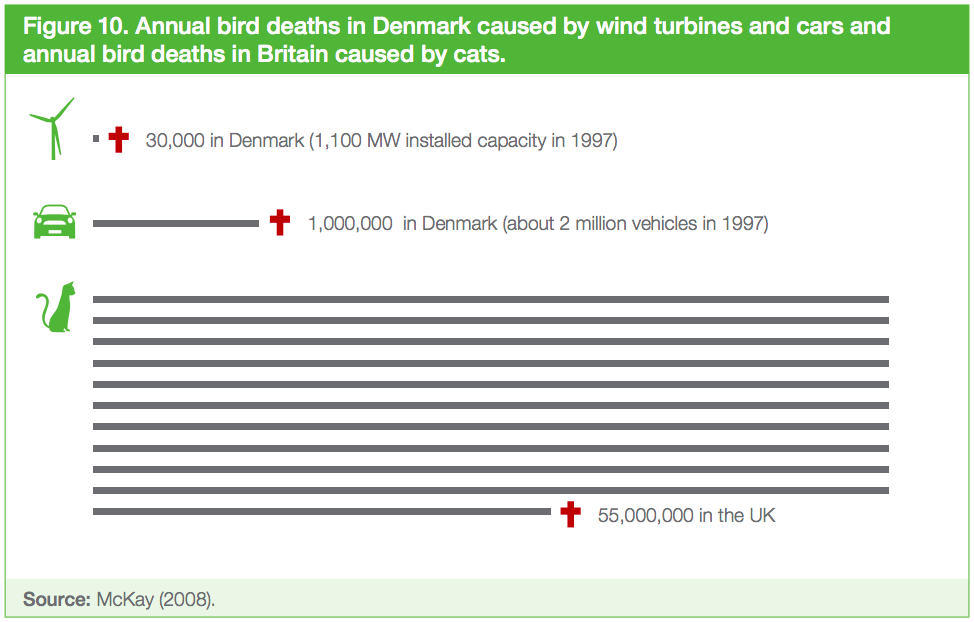
Above taken from The case for and against onshore wind energy in the UK (Grantham Institute)
Wind energy is better for the economy
Until now, the UK has relied on fossil fuels for the majority of electricity generation. Supplies in the North Sea are dwindling fast under increasing demand. As oil and gas become scarce, we must pay more to extract them, and compensate shortfalls by importing energy from overseas.
When we buy our energy outside of the UK, we’re subject to unpredictable market forces. A shortage in one country – due to political or civil unrest, for example – increases wholesale prices for the rest of us, which in turn, increases customer bills. Many large energy suppliers hedge against such rises by buying energy years in advance, but the premium for doing so is again borne by their customers.
If we embrace wind energy, we free ourselves from a volatile fuel market, stabilising the cost of electricity. We need only fund the materials, installation, and maintenance of wind farms, which are substantially lower than running a gas or coal-fired power station. Utilities pay less, the government pays less, and customers pay less – everybody wins.
Wind energy creates jobs, too. The Global Wind Energy Council estimated there were 1,155,000 jobs in wind energy at the end of 2016. In the UK, the Office for National Statistics reports that in 2016 the wind sector generated £6.4 billion turnover and employed around 14,000 FTEs (full-time equivalent workers), an increase on 2015’s figures. With widespread redundancies in the fossil fuel industry, the wind sector is a great opportunity for the next generation of energy employees to find skilled, well-paid, and secure work.
Does the UK have enough wind energy for its needs?
Yes and no. While the UK is windy enough to power the majority of its consumption, we’d need to cover a large portion of the country in wind farms to do so. Also, we’d need to ensure there were enough energy storage facilities to shore up wind energy for use in calmer weather, or when we need to feather the blades to protect wildlife.
Does that mean we shouldn’t build them? Certainly not. Wind is doing fantastically well already. In March this year, National Grid recorded the highest wind output ever of 13.2GW – meeting 37% of the UK’s energy needs.
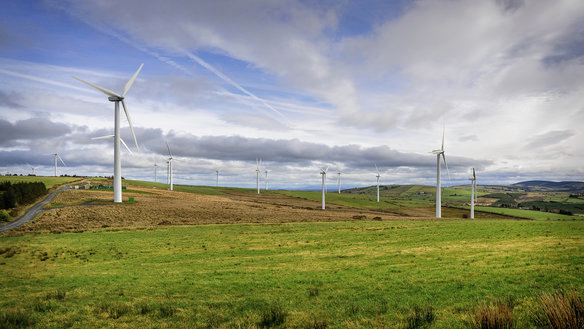
Beinneun, one of seven Octopus-backed wind farms supplying electricity to the National Grid
Octopus has backed eight wind farms in the UK, with a combined capacity of around 254MW. One the largest wind farms can be found at Beinneun, Scotland, rated at 108.8MW. Scotland has had huge success with wind power over the past few years, taking advantage of its high wind speeds on and offshore, and out-generating its demand by a considerable margin on certain weeks of the year.
“The UK is a naturally windy region, with specific areas like Scotland showing one of the highest average wind speeds in Europe. Due to this and advancing technology, wind energy contributes significantly to the UK’s electricity mix (15% in 2017), contributing to the UK’s 2020 renewable energy goals, and ensuring a sustainable energy strategy is in place for the future. With such high wind speeds, the UK is a candidate for launching unsubsidised wind energy, further reducing costs for end consumers while ensuring more polluting electricity sources participate less in the energy mix.”
Natalia Paraskevopoulou, Senior Commercial Asset Manager, Octopus Investments
Wind will continue to be a major contributor to the UK’s renewable energy mix, but it won’t be the exclusive one. Britain is uniquely placed to harness a range of renewable technologies – from solar to hydropower – which ensures a secure and sustainable source of power long into the future.
The future of wind power
There are few limits to wind’s adoption in the UK. Our blustery weather is perfectly suited, and private and public interests have shown considerable support in the past few years. However, to realise wind energy’s full potential, a few things must happen first.
Crucially, we need to upgrade the UK’s energy infrastructure. Much of it is decades old, and not equipped to deal with wind’s variability, nor the extent to which our electricity demand has grown. If we focus on building higher capacity networks, better reporting systems, and modern data analysis, integrating renewables like wind should be simple, and in the long run, cheap.
Also, we need to create grid-scale storage to balance supply and demand. When there’s too much electricity in the grid, for example, wind farm operators are paid to switch off their turbines. Until we’ve got the means to store excess electricity, or we can direct consumers to shift their demand, this waste of energy and money will continue.
Octopus has already begun helping National Grid overcome these challenges. First, through our partnership with Reactive Technologies, an innovative data management solution for grid balancing, and second, through Agile Octopus, a renewable energy tariff that incentivises customers to shift demand to cheaper times. These are early yet vital steps to a smart, sustainable energy system in Britain.
Wind power has survived its first few rounds with fossil fuels, and in many respects has come off the better fighter. Coal has been knocked out, and oil and gas are on the ropes. While it might be too early to declare wind the absolute winner, we know which future we’re putting our money on.
*Calculation based on one offshore 6 MW wind turbine powering 5,500 homes. Therefore, using total installed capacity of 487 GW, calculation becomes 5,500 x (487,000 / 6) = 446 million (to nearest million).

